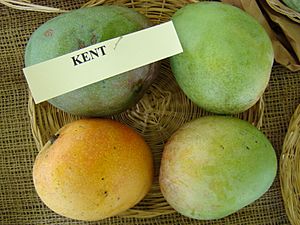Kent (mango) facts for kids
The 'Kent' mango is a special type of mango. It's a popular fruit that first grew in Florida, USA. People love it because it tastes sweet and doesn't have much stringy fiber.
Quick facts for kids Mangifera 'Kent' |
|
|---|---|

'Kent' mangoes at the Redland Summer Fruit Festival, Fruit and Spice Park, Homestead, Florida
|
|
| Genus | Mangifera |
| Hybrid parentage | 'Brooks' × 'Haden' |
| Cultivar | 'Kent' |
| Origin | Florida, USA |
History of the 'Kent' Mango
The very first 'Kent' mango tree started growing in September 1932. It was planted on January 1, 1933. This happened on the land of Leith D. Kent in Coconut Grove, Florida.
Scientists believe the 'Kent' mango is a mix of two other mango types. These are the 'Brooks' and 'Haden' mangoes. The first 'Kent' mango fruits appeared in 1938. It was officially named and described in 1945.
The 'Kent' mango quickly became very popular in Florida. People loved its great taste and how smooth it was. However, the tree could easily get a plant disease called anthracnose. Also, the fruit didn't stay fresh for very long. This made it harder to sell them in large amounts.
Today, 'Kent' mangoes are grown for sale outside the United States. They are especially popular in places like South America. In Florida, many people still grow 'Kent' mango trees in their homes. The 'Kent' mango is also a parent to other mango types. These include the 'Young' mango.
You can find 'Kent' mango trees in special plant collections. These collections help to save different types of plants. One such collection is at the USDA in Miami, Florida. The original 'Kent' mango tree still stands in Coconut Grove today.
In France, the 'Kent' mango is the main type of mango imported. Most of these mangoes come from South America and Africa.
What the 'Kent' Mango Looks Like
The 'Kent' mango tree grows very strongly. It has a neat, upright shape. It can grow quite tall, sometimes over 30 feet high. These trees usually produce many mangoes each year.
The fruit itself is usually oval-shaped. It often weighs between 20 and 26 ounces. The 'Kent' mango has a rich and sweet flavor. As it ripens, its skin changes color. It turns from green to a greenish-yellow. It might also have some red blush on it.
The seed inside the 'Kent' mango is special. It is called monoembryonic. This means it usually has only one plant embryo. If the fruit stays on the tree too long, the seed might start to sprout inside the mango. In Florida, 'Kent' mangoes usually ripen from July to August. Sometimes they ripen into September.
Images for kids


